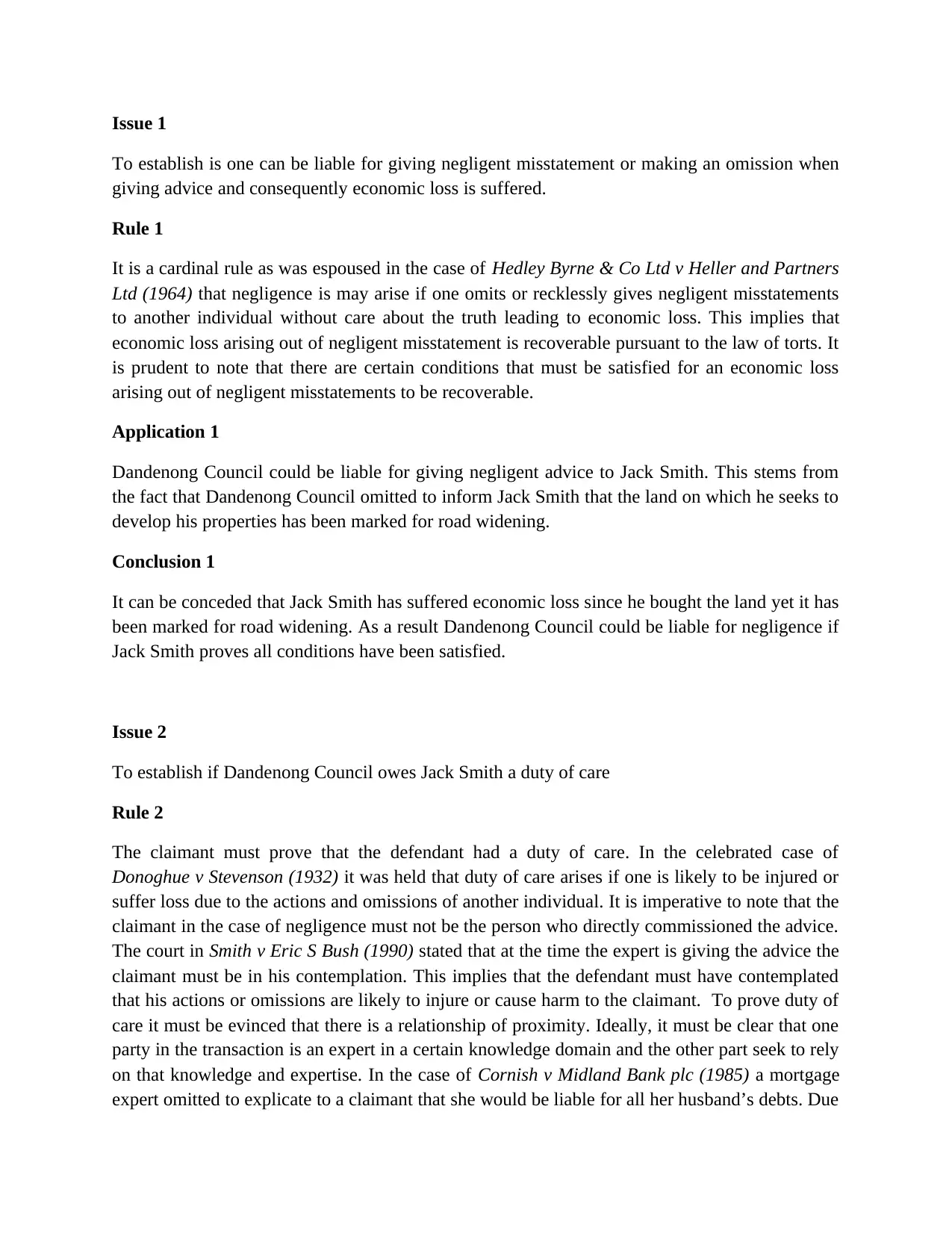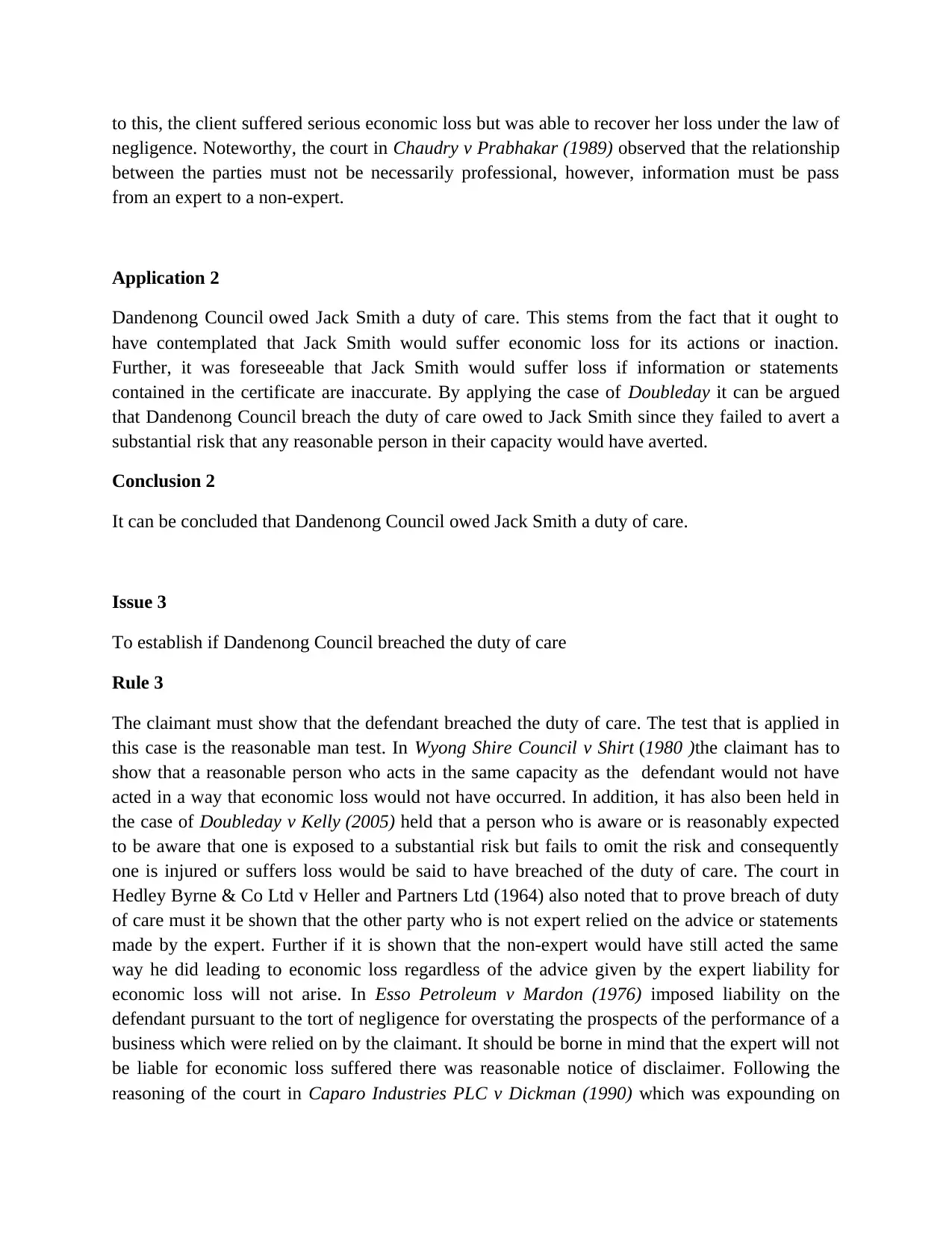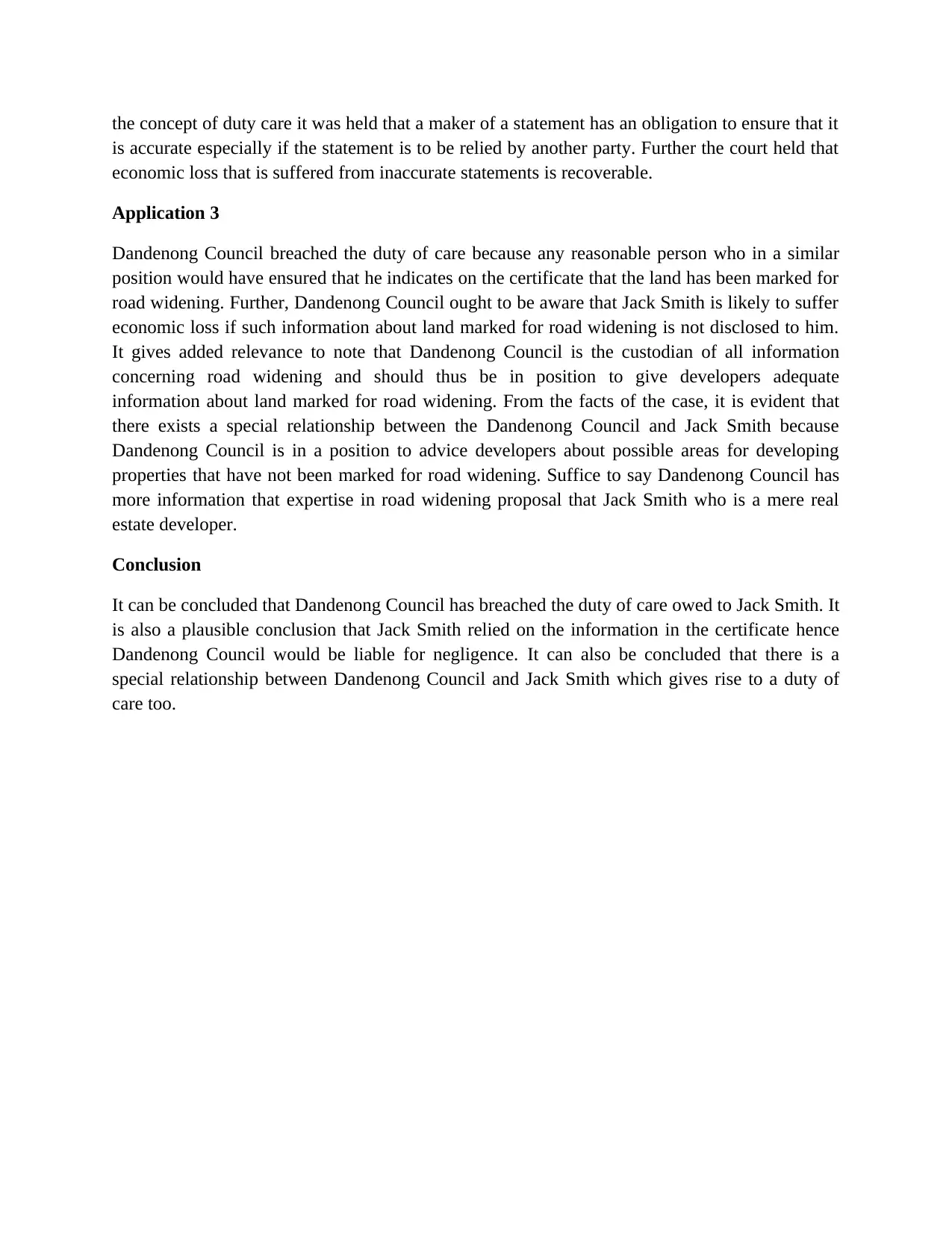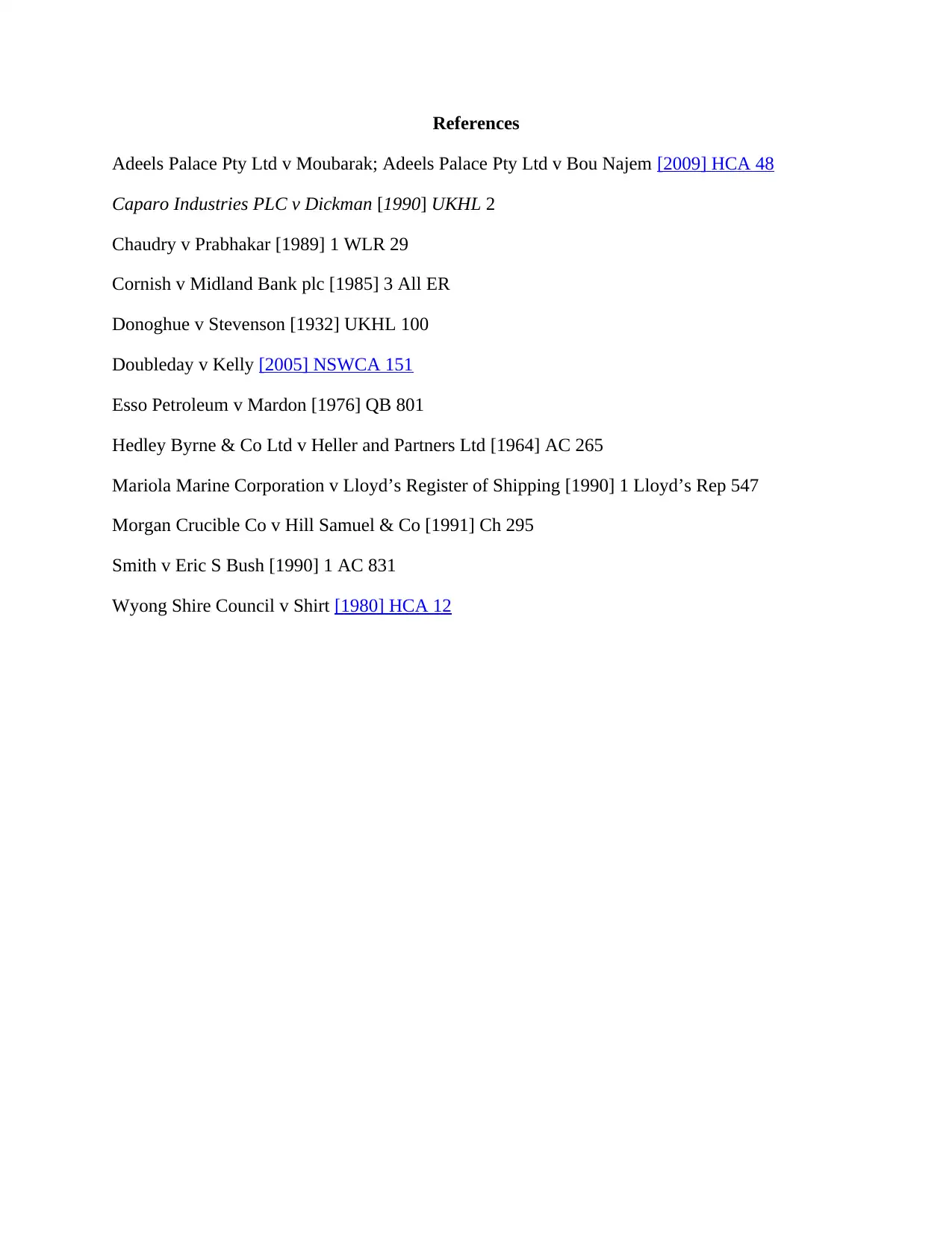Case Study Analysis: Negligent Misstatement and Duty of Care in Law
VerifiedAdded on 2023/03/20
|5
|1389
|67
Case Study
AI Summary
This case study examines the potential liability of Dandenong Council for negligent misstatement and the resulting economic loss suffered by Jack Smith. The analysis focuses on establishing whether the council is liable for providing negligent advice or making omissions regarding land designated for road widening. The assignment explores key legal principles, including the rule established in Hedley Byrne & Co Ltd v Heller and Partners Ltd (1964), the concept of duty of care as defined in Donoghue v Stevenson (1932) and Smith v Eric S Bush (1990), and breach of duty using the reasonable man test from Wyong Shire Council v Shirt (1980). The case study assesses whether the council owed a duty of care to Jack Smith, if that duty was breached, and if the council's actions or omissions led to economic loss. The conclusion suggests that Dandenong Council may be liable for negligence due to the breach of duty of care and the special relationship that existed between the council and Jack Smith.

Name:
School:
Date:
School:
Date:
Paraphrase This Document
Need a fresh take? Get an instant paraphrase of this document with our AI Paraphraser

Issue 1
To establish is one can be liable for giving negligent misstatement or making an omission when
giving advice and consequently economic loss is suffered.
Rule 1
It is a cardinal rule as was espoused in the case of Hedley Byrne & Co Ltd v Heller and Partners
Ltd (1964) that negligence is may arise if one omits or recklessly gives negligent misstatements
to another individual without care about the truth leading to economic loss. This implies that
economic loss arising out of negligent misstatement is recoverable pursuant to the law of torts. It
is prudent to note that there are certain conditions that must be satisfied for an economic loss
arising out of negligent misstatements to be recoverable.
Application 1
Dandenong Council could be liable for giving negligent advice to Jack Smith. This stems from
the fact that Dandenong Council omitted to inform Jack Smith that the land on which he seeks to
develop his properties has been marked for road widening.
Conclusion 1
It can be conceded that Jack Smith has suffered economic loss since he bought the land yet it has
been marked for road widening. As a result Dandenong Council could be liable for negligence if
Jack Smith proves all conditions have been satisfied.
Issue 2
To establish if Dandenong Council owes Jack Smith a duty of care
Rule 2
The claimant must prove that the defendant had a duty of care. In the celebrated case of
Donoghue v Stevenson (1932) it was held that duty of care arises if one is likely to be injured or
suffer loss due to the actions and omissions of another individual. It is imperative to note that the
claimant in the case of negligence must not be the person who directly commissioned the advice.
The court in Smith v Eric S Bush (1990) stated that at the time the expert is giving the advice the
claimant must be in his contemplation. This implies that the defendant must have contemplated
that his actions or omissions are likely to injure or cause harm to the claimant. To prove duty of
care it must be evinced that there is a relationship of proximity. Ideally, it must be clear that one
party in the transaction is an expert in a certain knowledge domain and the other part seek to rely
on that knowledge and expertise. In the case of Cornish v Midland Bank plc (1985) a mortgage
expert omitted to explicate to a claimant that she would be liable for all her husband’s debts. Due
To establish is one can be liable for giving negligent misstatement or making an omission when
giving advice and consequently economic loss is suffered.
Rule 1
It is a cardinal rule as was espoused in the case of Hedley Byrne & Co Ltd v Heller and Partners
Ltd (1964) that negligence is may arise if one omits or recklessly gives negligent misstatements
to another individual without care about the truth leading to economic loss. This implies that
economic loss arising out of negligent misstatement is recoverable pursuant to the law of torts. It
is prudent to note that there are certain conditions that must be satisfied for an economic loss
arising out of negligent misstatements to be recoverable.
Application 1
Dandenong Council could be liable for giving negligent advice to Jack Smith. This stems from
the fact that Dandenong Council omitted to inform Jack Smith that the land on which he seeks to
develop his properties has been marked for road widening.
Conclusion 1
It can be conceded that Jack Smith has suffered economic loss since he bought the land yet it has
been marked for road widening. As a result Dandenong Council could be liable for negligence if
Jack Smith proves all conditions have been satisfied.
Issue 2
To establish if Dandenong Council owes Jack Smith a duty of care
Rule 2
The claimant must prove that the defendant had a duty of care. In the celebrated case of
Donoghue v Stevenson (1932) it was held that duty of care arises if one is likely to be injured or
suffer loss due to the actions and omissions of another individual. It is imperative to note that the
claimant in the case of negligence must not be the person who directly commissioned the advice.
The court in Smith v Eric S Bush (1990) stated that at the time the expert is giving the advice the
claimant must be in his contemplation. This implies that the defendant must have contemplated
that his actions or omissions are likely to injure or cause harm to the claimant. To prove duty of
care it must be evinced that there is a relationship of proximity. Ideally, it must be clear that one
party in the transaction is an expert in a certain knowledge domain and the other part seek to rely
on that knowledge and expertise. In the case of Cornish v Midland Bank plc (1985) a mortgage
expert omitted to explicate to a claimant that she would be liable for all her husband’s debts. Due

to this, the client suffered serious economic loss but was able to recover her loss under the law of
negligence. Noteworthy, the court in Chaudry v Prabhakar (1989) observed that the relationship
between the parties must not be necessarily professional, however, information must be pass
from an expert to a non-expert.
Application 2
Dandenong Council owed Jack Smith a duty of care. This stems from the fact that it ought to
have contemplated that Jack Smith would suffer economic loss for its actions or inaction.
Further, it was foreseeable that Jack Smith would suffer loss if information or statements
contained in the certificate are inaccurate. By applying the case of Doubleday it can be argued
that Dandenong Council breach the duty of care owed to Jack Smith since they failed to avert a
substantial risk that any reasonable person in their capacity would have averted.
Conclusion 2
It can be concluded that Dandenong Council owed Jack Smith a duty of care.
Issue 3
To establish if Dandenong Council breached the duty of care
Rule 3
The claimant must show that the defendant breached the duty of care. The test that is applied in
this case is the reasonable man test. In Wyong Shire Council v Shirt (1980 )the claimant has to
show that a reasonable person who acts in the same capacity as the defendant would not have
acted in a way that economic loss would not have occurred. In addition, it has also been held in
the case of Doubleday v Kelly (2005) held that a person who is aware or is reasonably expected
to be aware that one is exposed to a substantial risk but fails to omit the risk and consequently
one is injured or suffers loss would be said to have breached of the duty of care. The court in
Hedley Byrne & Co Ltd v Heller and Partners Ltd (1964) also noted that to prove breach of duty
of care must it be shown that the other party who is not expert relied on the advice or statements
made by the expert. Further if it is shown that the non-expert would have still acted the same
way he did leading to economic loss regardless of the advice given by the expert liability for
economic loss will not arise. In Esso Petroleum v Mardon (1976) imposed liability on the
defendant pursuant to the tort of negligence for overstating the prospects of the performance of a
business which were relied on by the claimant. It should be borne in mind that the expert will not
be liable for economic loss suffered there was reasonable notice of disclaimer. Following the
reasoning of the court in Caparo Industries PLC v Dickman (1990) which was expounding on
negligence. Noteworthy, the court in Chaudry v Prabhakar (1989) observed that the relationship
between the parties must not be necessarily professional, however, information must be pass
from an expert to a non-expert.
Application 2
Dandenong Council owed Jack Smith a duty of care. This stems from the fact that it ought to
have contemplated that Jack Smith would suffer economic loss for its actions or inaction.
Further, it was foreseeable that Jack Smith would suffer loss if information or statements
contained in the certificate are inaccurate. By applying the case of Doubleday it can be argued
that Dandenong Council breach the duty of care owed to Jack Smith since they failed to avert a
substantial risk that any reasonable person in their capacity would have averted.
Conclusion 2
It can be concluded that Dandenong Council owed Jack Smith a duty of care.
Issue 3
To establish if Dandenong Council breached the duty of care
Rule 3
The claimant must show that the defendant breached the duty of care. The test that is applied in
this case is the reasonable man test. In Wyong Shire Council v Shirt (1980 )the claimant has to
show that a reasonable person who acts in the same capacity as the defendant would not have
acted in a way that economic loss would not have occurred. In addition, it has also been held in
the case of Doubleday v Kelly (2005) held that a person who is aware or is reasonably expected
to be aware that one is exposed to a substantial risk but fails to omit the risk and consequently
one is injured or suffers loss would be said to have breached of the duty of care. The court in
Hedley Byrne & Co Ltd v Heller and Partners Ltd (1964) also noted that to prove breach of duty
of care must it be shown that the other party who is not expert relied on the advice or statements
made by the expert. Further if it is shown that the non-expert would have still acted the same
way he did leading to economic loss regardless of the advice given by the expert liability for
economic loss will not arise. In Esso Petroleum v Mardon (1976) imposed liability on the
defendant pursuant to the tort of negligence for overstating the prospects of the performance of a
business which were relied on by the claimant. It should be borne in mind that the expert will not
be liable for economic loss suffered there was reasonable notice of disclaimer. Following the
reasoning of the court in Caparo Industries PLC v Dickman (1990) which was expounding on
⊘ This is a preview!⊘
Do you want full access?
Subscribe today to unlock all pages.

Trusted by 1+ million students worldwide

the concept of duty care it was held that a maker of a statement has an obligation to ensure that it
is accurate especially if the statement is to be relied by another party. Further the court held that
economic loss that is suffered from inaccurate statements is recoverable.
Application 3
Dandenong Council breached the duty of care because any reasonable person who in a similar
position would have ensured that he indicates on the certificate that the land has been marked for
road widening. Further, Dandenong Council ought to be aware that Jack Smith is likely to suffer
economic loss if such information about land marked for road widening is not disclosed to him.
It gives added relevance to note that Dandenong Council is the custodian of all information
concerning road widening and should thus be in position to give developers adequate
information about land marked for road widening. From the facts of the case, it is evident that
there exists a special relationship between the Dandenong Council and Jack Smith because
Dandenong Council is in a position to advice developers about possible areas for developing
properties that have not been marked for road widening. Suffice to say Dandenong Council has
more information that expertise in road widening proposal that Jack Smith who is a mere real
estate developer.
Conclusion
It can be concluded that Dandenong Council has breached the duty of care owed to Jack Smith. It
is also a plausible conclusion that Jack Smith relied on the information in the certificate hence
Dandenong Council would be liable for negligence. It can also be concluded that there is a
special relationship between Dandenong Council and Jack Smith which gives rise to a duty of
care too.
is accurate especially if the statement is to be relied by another party. Further the court held that
economic loss that is suffered from inaccurate statements is recoverable.
Application 3
Dandenong Council breached the duty of care because any reasonable person who in a similar
position would have ensured that he indicates on the certificate that the land has been marked for
road widening. Further, Dandenong Council ought to be aware that Jack Smith is likely to suffer
economic loss if such information about land marked for road widening is not disclosed to him.
It gives added relevance to note that Dandenong Council is the custodian of all information
concerning road widening and should thus be in position to give developers adequate
information about land marked for road widening. From the facts of the case, it is evident that
there exists a special relationship between the Dandenong Council and Jack Smith because
Dandenong Council is in a position to advice developers about possible areas for developing
properties that have not been marked for road widening. Suffice to say Dandenong Council has
more information that expertise in road widening proposal that Jack Smith who is a mere real
estate developer.
Conclusion
It can be concluded that Dandenong Council has breached the duty of care owed to Jack Smith. It
is also a plausible conclusion that Jack Smith relied on the information in the certificate hence
Dandenong Council would be liable for negligence. It can also be concluded that there is a
special relationship between Dandenong Council and Jack Smith which gives rise to a duty of
care too.
Paraphrase This Document
Need a fresh take? Get an instant paraphrase of this document with our AI Paraphraser

References
Adeels Palace Pty Ltd v Moubarak; Adeels Palace Pty Ltd v Bou Najem [2009] HCA 48
Caparo Industries PLC v Dickman [1990] UKHL 2
Chaudry v Prabhakar [1989] 1 WLR 29
Cornish v Midland Bank plc [1985] 3 All ER
Donoghue v Stevenson [1932] UKHL 100
Doubleday v Kelly [2005] NSWCA 151
Esso Petroleum v Mardon [1976] QB 801
Hedley Byrne & Co Ltd v Heller and Partners Ltd [1964] AC 265
Mariola Marine Corporation v Lloyd’s Register of Shipping [1990] 1 Lloyd’s Rep 547
Morgan Crucible Co v Hill Samuel & Co [1991] Ch 295
Smith v Eric S Bush [1990] 1 AC 831
Wyong Shire Council v Shirt [1980] HCA 12
Adeels Palace Pty Ltd v Moubarak; Adeels Palace Pty Ltd v Bou Najem [2009] HCA 48
Caparo Industries PLC v Dickman [1990] UKHL 2
Chaudry v Prabhakar [1989] 1 WLR 29
Cornish v Midland Bank plc [1985] 3 All ER
Donoghue v Stevenson [1932] UKHL 100
Doubleday v Kelly [2005] NSWCA 151
Esso Petroleum v Mardon [1976] QB 801
Hedley Byrne & Co Ltd v Heller and Partners Ltd [1964] AC 265
Mariola Marine Corporation v Lloyd’s Register of Shipping [1990] 1 Lloyd’s Rep 547
Morgan Crucible Co v Hill Samuel & Co [1991] Ch 295
Smith v Eric S Bush [1990] 1 AC 831
Wyong Shire Council v Shirt [1980] HCA 12
1 out of 5
Related Documents
Your All-in-One AI-Powered Toolkit for Academic Success.
+13062052269
info@desklib.com
Available 24*7 on WhatsApp / Email
![[object Object]](/_next/static/media/star-bottom.7253800d.svg)
Unlock your academic potential
Copyright © 2020–2025 A2Z Services. All Rights Reserved. Developed and managed by ZUCOL.





